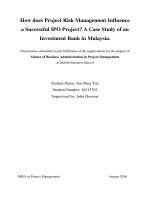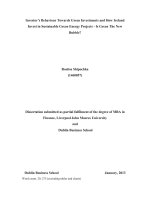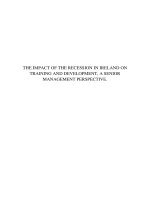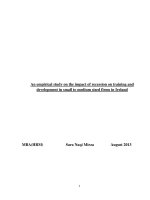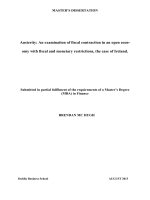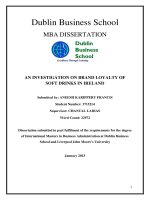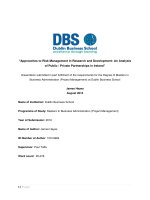Master Thesis in Economics: Ireland as a new destiny for Brazilian nurses
Bạn đang xem bản rút gọn của tài liệu. Xem và tải ngay bản đầy đủ của tài liệu tại đây (3.27 MB, 121 trang )
Ireland as a new destiny for Brazilian
nurses
Dissertation submitted in part of fulfilment of the requirements for the
degree of Masters of Business Administration in Project Management at
Dublin Business School
Thais Martins da Silva
10372558
MBA in Project Management
August 2018
DECLARATION
I, Thais Martins da Silva, declare that this research is my original
work and that it has never been presented to any institution or
university for the award of Degree or Diploma. In addition, I
have referenced correctly all literature and sources used in this
work and this work is fully compliant with the Dublin Business
School’s academic honesty policy.
___________________________________
____________________________
Thais Martins da Silva
Date
Contents
CHAPTER I - INTRODUCTION ...................................................................... 8
Introduction ...................................................................................... 8
Background ....................................................................................... 9
Rationale of the Research ..................................................................... 10
Research Question .............................................................................. 11
Sub questions .................................................................................. 11
Problem Statement ............................................................................. 12
Rationale of the Study ......................................................................... 12
Significance of the Study ...................................................................... 13
Research Hypothesis ........................................................................... 13
Research Aim and Objectives ................................................................. 14
Research Structure ............................................................................. 15
CHAPTER II – LITERATURE REVIEW .............................................................. 16
Literature Introduction ........................................................................ 16
Economic conditions ........................................................................... 16
Comparison between Brazil and Ireland’s life conditions .............................. 16
Living Abroad .................................................................................. 22
Brazilians and English Language in Migration ............................................ 25
Nursing sector in Brazil and in Ireland ...................................................... 31
Nursing sector in Brazil ...................................................................... 31
Nursing sector in Ireland .................................................................... 35
Shortage of nurses in Ireland ............................................................... 38
International sourcing of nursing professionals .......................................... 39
Recruitment matters ........................................................................... 40
Migration of nurses: motivation and challenges ......................................... 41
Overseas Registration process in Ireland.................................................. 43
Retention in the Nursing industry .......................................................... 48
Media on International Recruitment ....................................................... 51
CHAPTER III – RESEARCH METHODOLOGY ...................................................... 54
Methodology Introduction ..................................................................... 54
Research Design ................................................................................. 55
Research Philosophy .......................................................................... 55
Research Approach ........................................................................... 56
Research Strategy ............................................................................ 56
Sampling.......................................................................................... 56
Data Collection .................................................................................. 57
Data Analysis .................................................................................... 57
Time Horizon .................................................................................... 57
Research Ethics ................................................................................. 58
Research Limitations ........................................................................... 58
CHAPTER IV – DATA ANALYSIS AND FINDINGS ................................................. 59
Introduction ..................................................................................... 59
The questionnaire .............................................................................. 59
CHAPTER V – DISCUSSION ......................................................................... 78
CHAPTER VI - CONCLUSIONS AND RECOMMENDATIONS ...................................... 89
REFERENCES ........................................................................................ 94
APPENDIX ......................................................................................... 101
APPENDIX A – SELF-REFLECTION ............................................................ 101
APPENDIX B – SAMPLE QUESTIONNAIRE .................................................... 105
APPENDIX C – CONSENT FORM............................................................... 109
APPENDIX D – GROUP OF BRAZILIAN NURSES IN IRELAND ON FACEBOOK ............. 110
APPENDIX E – SAMPLE OF THE MANUAL IN PORTUGUESE FOR NURSES BY THE
RESEARCHER ................................................................................... 111
APPENDIX F – JOB DESCRIPTION 2018 BY THE RESEARCHER ............................ 116
APPENDIX G – NMBI WEBSITE ................................................................ 121
LIST OF FIGURES
Figure 1: Better Life Index – Ireland X Brazil ................................................. 17
Figure 2: PISA index ............................................................................... 19
Figure 3: Brazil Better Life Index ............................................................... 21
Figure 4: Ireland Better Life Index ............................................................. 21
Figure 5: Expats Profile .......................................................................... 24
Figure 6: World Ranking - English Language .................................................. 27
Figure 7: Brazil English Language Ranking .................................................... 28
Figure 8: Class C spending ....................................................................... 29
Figure 9: Nurses per 1,000 inhabitants in 2017 ............................................... 37
Figure 10: Pathways to meet NMBI English Requirements .................................. 44
Figure 11: English Requirements NMBI ......................................................... 45
Figure 12: NMBI's five steps ...................................................................... 46
Figure 13: Outcome of Assessment NMBI ...................................................... 47
Figure 14: Research Methods Table ............................................................ 54
Figure 15: Gender of Respondents ............................................................. 60
Figure 16: Age category of Respondents ...................................................... 61
Figure 17: Profession of Respondents .......................................................... 62
Figure 18: Years of Experience of Respondents .............................................. 63
Figure 19: International Work Experience of Respondents ................................. 64
Figure 20: International Experience as a Nurse of Respondents ........................... 65
Figure 21: Reasons driving Nurses Abroad ..................................................... 66
Figure 22: Good Reasons to Live in Ireland ................................................... 68
Figure 23: Hesitation of Brazilians to Go Abroad ............................................ 69
Figure 24: Challenges of Adaptation in Ireland ............................................... 70
Figure 25: Awareness of Registration Requirements ........................................ 71
Figure 26: English Level of Respondents ...................................................... 72
Figure 27: Respondents Living in Ireland ...................................................... 73
Figure 28: Occupation of Respondents Living in Ireland .................................... 74
Figure 29: Working Place of Respondents in Ireland ........................................ 75
Figure 30: Incentives to Start the Process .................................................... 76
Figure 31: Incentives to work in Ireland ....................................................... 77
AKNOWLEDGMENTS
I would like to express my appreciation to my dissertation supervisor, Shaun Hayden,
who supported me during the research process and offered valuable advice on my
research.
Immeasurable appreciation and deepest gratitude for the help and support are
extended to the following persons who in one way or another have contributed in
making this study possible.
All the lecturers who shared their valuable knowledge during this course.
My parents: Antonia and Roberto, my siblings: Thalita and Roberto, and my nephews
Oliver and Dimitri, who gave me the strength to face this international experience,
even not coming back home for 3 years. Thanks family for your insight, inspiration,
wisdom and intellectual capacity. Thanks for your love and support, nothing would be
possible without your care.
My friends, Loruama, Femin, Nantha, Isabelle, Marcela, Diego, Emanuvel and Bruno who
boosted me morally and provided me great support when doing this research also
through the year, who were always ready to help in the hard days and were always
ready to celebrate on my achievements.
Karthik Sheelam, my best friend, who was with me every single second, keeping me
happy and strong, while I faced so many challenges and loses during this period.
Jared Gormly, who believes on my potential and have been an inspiration for my career.
In addition, I would like to thank you to all participants of my interview from Brazil and
Ireland.
ABSTRACT
The purpose of the research topic is to evaluate the motivations that would drive
Brazilian nurses to immigrate to Ireland for working. The focus are Brazilian nurses in
general, registered, technicians and assistants, who live in Brazil or not. This group of
professionals already shows interest on working in Ireland since the researcher have
contacted some of them in her recruitment project. However, there are barriers such
as language which need to be overcome, and for that there is a need of understanding
the motivation behind the desire of immigrate to Ireland and what are the expectations
and fears.
Despite of the experience of Ireland in recruiting international nurses, Brazilian nurses
need different strategies, since they don’t speak enough English in general and they
are not aware of the opportunities.
The research strategy used in this study is the quantitative method, sampling size of
126 people. The nurses were approached by Facebook groups, LinkedIn and WhatsApp.
The aspects explored was the drivers of immigration for Brazilian nurses, hesitation
factors, adaptation challenges, English level, work experience, the economic situation
of Brazil and Ireland and the nursing sector in each country among others.
This research will provide valuable information regarding the profile of nurses from
Brazil and strategies of approach for this specific public.
Keywords: Brazilian nurses, Brazilian economy, Irish Economy, Shortage of nurses,
International recruitment, Media in recruiting, nurse immigration, migration,
registration of nurses, Living abroad.
CHAPTER I - INTRODUCTION
Introduction
The migration of nurses is happening for a while, the reason of that is the shortage of
professionals in the nursing industry and on the other hand professionals from
developing countries who are seeking for better quality of life. It is important to
understand that the shortage is worldwide, and it makes the developed countries start
a “War for Talent” where the nurses who are prepared can get space and better quality
of life, and countries that offer better pay rates and work conditions get more
professionals addressing their shortage.
Ireland is one of the countries that have been sourcing nursing professionals in
developing countries. For few years its focus has been India, Philippines, Africa among
other English speaker countries. However, with the great number of Brazilian
immigrants in Ireland, considering that Brazil is also facing a recession due to its
political situation, the idea of hiring Brazilian nurses was brought to the researcher of
this study.
Brazilians in general have intermediate level of English or even none due to its weak
teaching system of the language. That was already known as one of the barriers but, it
is necessary to understand first what the motivations for Brazilians would be to
overcome the barriers and explore the idea of working in Ireland, to then elaborate
strategies and invest on this new public.
This research is concentrated on the study of Ireland as being a new destiny for Brazilian
nurses, comprehending their motivations, hesitations, expectations, worries, desires
and presenting reasons why Ireland would be a good place for them, considering mainly
economic conditions, since as said before, Brazil is facing a recession and the politics
are currently very unstable. The research also brings strategies for HSE and the
recruitment process in Ireland.
8
Background
Studies have shown that factors linked to job prospects, such as better working
conditions and quality of life, are some of the key issues that influence the migration
of health professionals. The nursing professional population in Brazil is one of the
largest in the Country, as of 2011 census there were 1.6 million registered nursing
professionals in Brazil. Over 300,000 were professional nurses, 700,000 were nursing
technicians, and over 500,000 were from nurse auxiliaries. The nursing education is also
gaining interest in the country, the number of people enrolled for the nursing education
has doubled during the period 2004 to 2008 (Silva, et al., 2016).
Canada, the United States, the United Kingdom and Australia for a while have been the
top destination countries for International Educated Nurses (IENs). International nurses
have been widely considered important as a potential solution for health workforce
shortages in developed countries. Destination countries are benefited from gaining
educated and experienced nurses to fill the gaps in their health system, on the other
hand the source countries lose their valuable health human resources time after time
increasing their already existing critical shortages (Covell et al., 2017).
Ireland is also well known for the source of immigration to other countries, however
the trend is reversing in the recent years due to relaxed immigration policies and skill
shortage of professionals. The countries like Germany and France well known in the last
few decades in attracting the immigrants have regulated the immigration, but the
countries like Ireland, Spain and Greece have started attracting immigrants from all
over the world. The percentage of foreign born national in Ireland has increased from
less than 5% to approximately to 20% during the last four decades. The increase in
immigration in Ireland was primarily due to the impressive economic growth rate of
Ireland, between 1990 to 2008 the country’s average economic growth rate was 4.7%.
The second important reason was shortage of skilled labors and the immigration rule
were modified to fulfill the gap in skilled labor (Bustillo and Antón, 2010).
9
The healthcare professionals in Ireland are in shortage as the number of trained nurses
continuing work in Ireland is considerably lesser than the required number of nurses in
a year. Some of the reasons for the shortage of Irish nurse are Ageing population,
increase in the complexity of healthcare system, shortage of trained professionals in
support functions like Physiotherapy, and the increased burden of doctor’s
responsibility restricting nurse’s productivity. From the supply side, there is the
attractive opportunities available for the Irish Trained nurses in other countries. It is
also convenient for the healthcare recruiters to recruit from other countries since the
experienced nurses are available at a shorter notice and relatively low salary
(Humphries, Brugha, and McGee, 2008).
Historically, the Brazilian nurses weren’t not the target market for the Ireland
recruitment agencies. For instance, in 2015 and 2016, the top five countries from which
the HSE sources the nurses are India, Philippines, and Pakistan (NMBI, 2017). The
nursing shortage crisis in Ireland provided an opportunity for the educated Brazilian to
look to migrate to Ireland as the pay and living conditions are perceived to be better.
Currently Brazilians already have been migrating to Ireland, foreign-born people now
make up just more than 17% of the population, at 810,406 people where one the fastestgrowing groups were Brazilians (up 6,498) after Romanians (up 10,707) and before
Spanish (up 4,806) (Census 2016, 2017).
Rationale of the Research
Few researches have considered and evaluated the migration of nurses worldwide also
its effect on the developed and developing countries. The movement of professionals
from Brazil is caused by the low economic development of country and regions, the
deficiencies in living conditions, and the lack of opportunities for professional
development. (Silva et al., 2016).
Ireland is becoming a destiny for many Brazilians, according to the Brazilian Educational
& Language Travel Association (BELTA), Ireland was the fourth most sought country for
students and professionals. The reason for that was the quality of life, safety,
localization, and the possibility of combine work and study (Maes, 2018).
10
Filling this research could provide more information on the reasons, expectations and
worries of nurses from Brazil when they consider Ireland as new destiny of migration.
In the future, the outcome will be useful for the Health Service Executive (HSE) and
agencies to create strategies and methods of recruiting nurses from Brazil. Brazilian
nurses could also use the study to help in their acknowledgment about Ireland and the
opportunity of working in the country.
Research Question
What would be the motivation for Brazilian nurses to immigrate to Ireland?
The research question will help us to understand what the nurses from Brazil are seeking
for and if it will be possible to fulfill their expectations. It is considered that there is
already a very strong desire from them since the researcher works as recruiter in a
project of recruiting nurses from Brazil, also there is desire from HSE do explore new
cultures such as Brazilians than just Indians and Philippines. The project is ongoing for
more than 1 year, and there are a lot of nurses interested on working abroad, in Ireland.
However, there is still a gap between the recruitment strategy and the candidates
which needs to be studied.
Sub questions
What are the barriers for Brazilian nurses to immigrate to countries like Ireland?
There is clearly an opportunity available for the Brazilian nurses to migrate to Ireland
since there is a skill shortage in Ireland and the quality of education in Brazil is also
improving over the years. But the number of Brazilians nurses migrating to Ireland is
very lower compared to other countries. This question will find out the barriers to
nurses’ migration from Brazil, based on the research outcome the recruiters can work
to mitigate the barriers.
Why Ireland would be a good country for Brazilian nurses to work abroad?
This question will help the recruiters who sourcing for nurses from Brazil to understand
the reasons that make Ireland a better place to live and work than Brazil. Considering
11
this information would help to build a strong strategy of approaching to the future
candidates.
What are the adaptation challenges once living in Ireland?
For a few reasons commonly known, even being a great place to live, Ireland would be
a bit challenging. By considering these factors, Brazilian nurses could evaluate better
their own expectations also be psychologically prepared to face these specific
situations.
What are the requirements to register as a nurse in Ireland?
It is extremely important to understand the requirements to become a registered Nurse
in Ireland, all the rules and requirements are given by the Nursing and Midwifery Board
in Ireland (NMBI). Once acknowledged all the steps, the recruiters and the future
candidates will be able to plan step by step, focus and stress only on the valuable
actions.
There are few nurses from Brazil living in Ireland, so what are they doing in Ireland
and why they are yet to get registered?
Identifying few nurses living in Ireland and understanding what their reality is will help
to build stronger strategies to ensure that Brazilian nurses will be able to achieve their
registration in an acceptable period, without dragging steps.
Problem Statement
The Irish health system (HSE) is known for its shortage of healthcare professionals, being
one of the employers of professionals of India, Philippines and Nigeria. Currently there
are the possibility to also employ people from Brazil. However, it seems Brazilian
people are not ready yet to start the process of registration, even sometimes they are
already living in Ireland.
Rationale of the Study
The study will fill the existent gap to understand the expectations and worries on
Brazilian nurses related to moving to Ireland for work.
12
Once eliminating the lack of information, the recruitment of this specific public will be
more assertive in terms of strategies on attraction, approaching, recruitment structure
and retention.
It also associates the researcher’s aspirations with becoming an International
Healthcare Recruiter in Ireland, and accordingly, in-depth knowledge of Brazilian
nurses’ motivations in this industry is going to contribute her chances of success in her
chosen career path and on the project which she already holds.
Significance of the Study
The findings of this study will redound to benefit of healthcare system in Ireland and
Brazilian nurses who are looking for international experiences. The greater demand of
healthcare professionals in Ireland justifies the need of different strategies and sources
of workforce. Thus, nurses who participate and understand the outcome of this research
will be able to acknowledge what to expect from working in Ireland and what are the
requirements of NMBI to get registered. That supports them on taking decisions and
planning their journey accordingly. Agencies will be guided on what should be
emphasized in the approaching to attract and engage future candidates on the
challenge of the registration process. For the researcher, the study will help her to
uncover critical information in the recruitment of this specific group that haven’t been
explored yet. Thus, new information and theory on recruitment practices of overseas
candidates may be arrived at Ireland.
Research Hypothesis
The research was conducted in the light of the following assumptions:
For Brazilian Nurses:
1. Low remuneration in comparison with great responsibility and social
expectations play a vital role in deciding for immigration
2. Mental and physical stress due to a high demand of work and insufficient number
of nurses plays a vital role in deciding for immigration
13
3. Low level of social respect for people practicing the profession in healthcare
plays a vital role in deciding for immigration
4. Political situation in Brazil plays a vital role in deciding for immigration
5. There is not enough financial condition to invest on a premium English education
6. No awareness of the opportunity and requirements
For Recruitment Process:
1. The language is a barrier
2. The opportunities are not clear
3. The registration process is not clear
4. There is a need of investments on attracting strategies, and financial support in
the first steps in some cases.
Research Aim and Objectives
The research outcome would help to build a structured recruitment process specially
for Brazilians as there could be few barriers for immigration. It would contemplate the
timeframe and strategies to motivate Brazilian nurses to overcome the barriers and
prepare themselves to apply for registration in the NMBI. The following are the main
aim of this study:
Identify reasons behind the immigration for Brazilian Nurses
Identify strong conditions in working and living specifically in Ireland
Understand the average of English level of Brazilian Nurses
Identify Brazilian nurses who already live in Ireland to understand what they are
currently doing
Understand the awareness of the opportunity and on the requirements
Identify the barriers of the immigration process for Brazilian nurses
Recommendation on strategies of recruitment and attraction
14
Research Structure
Introduction
The first chapter is the overview of the research and the achievements which the
researcher is seeking for, with introduction, background, aims, objectives, significance
and rationale of the study among others.
Literature Review
This chapter discuss the studies and relevant theories related to the topic chosen for
research.
Research Methodology
The research methodology will be explained step by step, including data collection,
sample size and research philosophy used.
Data Analysis and Interpretations
The results on the research will be discussed on this chapter, clarifying the collected
data.
Discussion
The fifth chapter is to relate the theory and the analysis of the collected data.
Recommendations and Conclusions
A conclusion between the theories and the research objectives also the collected data
shall be presented on this chapter. The researcher will share recommendations that
might boost the recruitment of Brazilian nurses, which also will help them to have their
international experience.
15
CHAPTER II – LITERATURE REVIEW
Literature Introduction
The literature review section will be helpful to understand the existing academic
articles published regarding the components of the research and sub-research
questions.
Economic conditions
When the desire to live abroad exists, it comes from diverse reasons, but mostly for
economic conditions. Ireland is already perceived by Brazilians as a better place to live
than Brazil. Although the community of Brazilians in Ireland has been increasing with
the time, living abroad still being a challenge, English language still a barrier for most
of Brazilians and on top of that cultural aspects.
Comparison between Brazil and Ireland’s life conditions
Developed countries are commonly known for its quality of life, on education, health,
safety, life expectancy, and employment conditions. For that reason, according to
(OECD Better Life Index, 2018) Brazil, being a developing country, compared with
Ireland shows that there are a few indexes which are way different, mainly in terms of
education, housing, safety, income, jobs, environment conditions among others.
16
Better Life Index in 2017
6.4
WORK-LIFE BALANCE
0.1
SAFETY
8.8
6.6
7.8
6.6
9
6.2
7.3
5.5
7.3
LIFE SATISFACTION
HEALTH
CIVIC ENGAGEMENT
ENVIRONMENT
1.4
EDUCATION
7.9
7.4
6.4
COMMUNITY
5.5
JOBS
8.9
7.5
0.3
INCOME
34
4.7
HOUSING
0
5
7.5
10
15
Brazil
20
25
30
35
40
Ireland
FIGURE 1: BETTER LIFE INDEX – IRELAND X BRAZIL
Source: OECD Better Life Index (2018)
Even after more than a decade, Brazil haven’t changed much, according to
Joychelovitch (1995) it is possible to observe the reality of Brazil without any in-depth
study, it reveals corruption, violence, nepotism, patronage and inequalities, also a deep
lacunae between constitutional rights and daily life that for many people, are deprived
of citizenship, corruption and impunity are old issues.
According to Lino and Matsunaga (2018) currently, Brazil has a big demand on
techniques which will help in the criminal investigations, since the country is in the 10th
position on the ranking of countries with the biggest index of homicides per 100
thousands habitants. While Ireland, according to Mundi (2018) is in the 180th position,
what explains why the Safety is 0.1 while Ireland is in 8.8 in the graph above.
The second indicator in the graph which had more disparity after safety was the income,
where according to Statistic (2018) the gross income distribution among tax payers in
Brazil in 2015, based on their declared average monthly income was: the richest portion
of Brazilian personal income taxpayers (0.1 percent) declared an average gross income
17
of 135,103 Brazilian reals per month. The average gross income declared by half of
Brazilian personal income taxpayers in 2015 amounted to 1,640 Brazilian reals per
month. Ireland, according to The Examiner (2018), has one of the best rates of income
distribution in the European Union. New figures from Eurostat show that the richest 20%
of the population in Ireland on average only earn 4.4 times more than the poorest 20%.
This shows that Ireland's policy of redistributing wealth by collecting taxes and paying
welfare contributes toward creating a fairer society.
According to Insider (2018) the PISA is a worldwide exam administered periodically
(every three years) that measures 15-year-olds in 72 countries. In 2015 around 540,000
students took the exam. The difference between Ireland and Brazil is huge as is possible
to see in the next figure, Brazil is close to the bottom in the three kind of exams, while
Ireland is above the average on all them. It means the Irish education system is more
efficient than in Brazil.
18
FIGURE 2: PISA INDEX
Source: Insider (2018)
19
The fourth lowest indicator of Brazil on the Figure 1 is related to Housing. Although the
program called “Minha casa Minha vida”, of the President Lula, had created conditions
for the expansion of the housing market for families with an income of up to 10
minimum wages, the problems related to a lack of housing have not yet been fully
solved (Monteiro et al., 2017). With the urbanization, there was a lack of necessary
investments, what forced the people who arrived in the metropolis to solve their house
problems through self-construction, which was precarious and later, the population
made up the so known “favelas”. According to Monteiro (2017) the housing issue in
Brazil is because of the cities were not prepared respond to such a large demand of
new residents, resulting in their disorderly expansion and affecting, not enough, the
working class, which due to the lack of resources began living in improvised, unhealthy
and inadequate housing.
Ireland currently has a light crises specifically on the capital, as Census 2016 (2017)
states almost 10% of the population in accommodation is with less than 1 room per
person. But still, compared with Brazil, Ireland is a better choice since in Brazil there
are even slums and more homeless people. According to Phillips (2017) Brazil has
slumped into its worst recession for decades, with 14 million people unemployed, and
there are even more people on the streets. In 2014 Brazil celebrated its removal from
the UN hunger map. Unfortunately, the big country is in danger again, a new report
warns, of being reinstated.
20
BRAZIL
SAFETY
INCOME
EDUCATION
HOUSING
ENVIRONMENT
JOBS
CIVIC ENGAGEMENT
WORK-LIFE BALANCE
COMMUNITY
LIFE SATISFACTION
HEALTH
0.1
0.3
1.4
4.7
5.5
5.5
6.2
6.4
6.4
6.6
6.6
0
1
2
3
4
5
6
7
FIGURE 3: BRAZIL BETTER LIFE INDEX
Source: OECD Better Life Index (2018)
If ordered the Brazilian indicators in crescent order is possible to see, apart from
health, all the basic conditions are on the top, as the lowest levels, the indicators in
total make an average of 6, while Ireland keeps an average of 7, what makes the Irish
country a better place to live than Brazil in terms of basic life conditions.
IRELAND
ENVIRONMENT
7.3
CIVIC ENGAGEMENT
7.3
EDUCATION
7.4
HOUSING
7.5
JOBS
7.5
LIFE SATISFACTION
7.8
WORK-LIFE BALANCE
7.9
SAFETY
8.8
COMMUNITY
8.9
HEALTH
9
INCOME
34
0
5
10
15
20
25
30
35
FIGURE 4: IRELAND BETTER LIFE INDEX
Source: OECD Better Life Index (2018)
21
Living Abroad
The human being has the capacity to be “connected” to his origin place, then
establishing a relationship between the places which he chooses as destiny and his
home. This phenomenon is one of the characteristics of migration (COGO, 2012).
According to (Manea, 2012) migration is an important part of education surpassing the
institutional limits of education, like schools, universities, academies etc. to the
international education process in the society as a whole. The migration promotes
cultural adaptation and education, it changes habits, knowledge and skills are achieved
or change through this experience. Language, customs, values are added to the ones
that the migrants already had in the origin country. The whole life experience is a
learning experience, this plays a vital role in the human evolution, cultivating
flexibility, adaptability and the learnings come from the existential experience of
leaving your own country more than just learning with the contact with a new culture.
According to the International Relations Ministry in 2011, based on reports of 2010 to
the Embassies and Consuls of Brazil, there was 3.122.813 Brazilians living abroad.
Developing countries are the top countries when it comes to migration, the reasons are
widely known, their people are mainly looking for education, safety, career
opportunities, health conditions and incomes. Apart from the basic reasons, there is
another social aspect, for instance, when talking about Brazilians, friends and relatives
has a vital role in the international migration, being them in the origin place or even in
the destiny place, besides the common reasons, people want to explore new
experiences and sensations, also meet the relative family who already live in the
destiny country (Garcia, Bitencourt Neto and Góes, 2013).
According to Expat Insider (2017) nowadays, there are an estimated 56 or 57 million
expats worldwide, and the term “expat” is no longer limited to corporate assignees
relocating from a company’s HQ. Some people moved for their career, some for love
22
and others just for the adventure, according to the organisation, they are classified in
ten different expat types, based on the main motivation for relocating, which are:
The Romantic: represents 12% of the whole group.
The Family Expat: represents 3% of the whole group.
The Dream Destination Expat: represents 4% of the whole group.
The Greener Pastures Expat: represents 14% of the whole group.
The Adventurer: represents 10% of the whole group
The Foreign Assignee: represents 11% of the whole group
The Career Expat: represents 14% of the whole group
The (Ex-) Student: represents 5% of the whole group
The Traveling Spouse: represents 10% of the whole group
Out of that, the Greener Pastures and the Career are the majority of expats (28%
together), who are looking for quality of life, financial reasons, retirement or because
they found a job, or wanted to start their own business in the destiny country.
23
FIGURE 5: EXPATS PROFILE
Source: Expat Insider (2017)
According to Expat Insider (2017) to be satisfied living abroad you need to have a
balance between 5 factors mainly:
24
Quality of life: leisure options, personal happiness, travel and transport, health and
well-being, safety and security.
Easy of Settling In: felling welcome, friendliness, finding friends, language.
Working Abroad: Job and career, work-life balance, job security.
Family Life: Availability/Costs of childcare and education, quality of education, family
well-being.
Personal Finance: Income, capacity of saving and investing.
Apart from what people who live abroad expect, the process of migration also implies
a multidimensional learning process, starting with the language, customs, professional
learning and maybe culminating with a change of lifestyle and personal values. The
individuals are situated at the point of confrontation between two cultures, and the
“adaptation process” is actually a continuous dialogue between those cultures. The
individual efforts of understanding the new culture and to understand her or his own,
or to situate her – or himself in this new social-cultural landscape is trapped in a
hermeneutic circle. The migrant person understands her or himself as part of a nations,
or as belonging to a professional branch, and may notice differences that were invisible
before migrations. The learning processes are socio-critical processes as well, and
sometimes the acknowledgment of one’s own values or principles is an important stage
in the process of changing, or on contrary accentuating them (Manea, 2012).
Brazilians and English Language in Migration
Currently, there are a great number of teachers teaching English without proper
qualifications, the teaching of English in Brazilian schools is carried out in less than
ideal conditions (Gimenez et al., 2016).
According to Xavier (2014) in the public secondary schools of some regions in Brazil, the
teaching methodology still predominating on grammar-translation, commonly because
of large class sizes and poor classroom acoustics, the absence of language labs and
equipment, not to mention difficulties with regards to both teacher oral proficiency
and student indiscipline. English teachers and teacher educators need to find ways to
25
